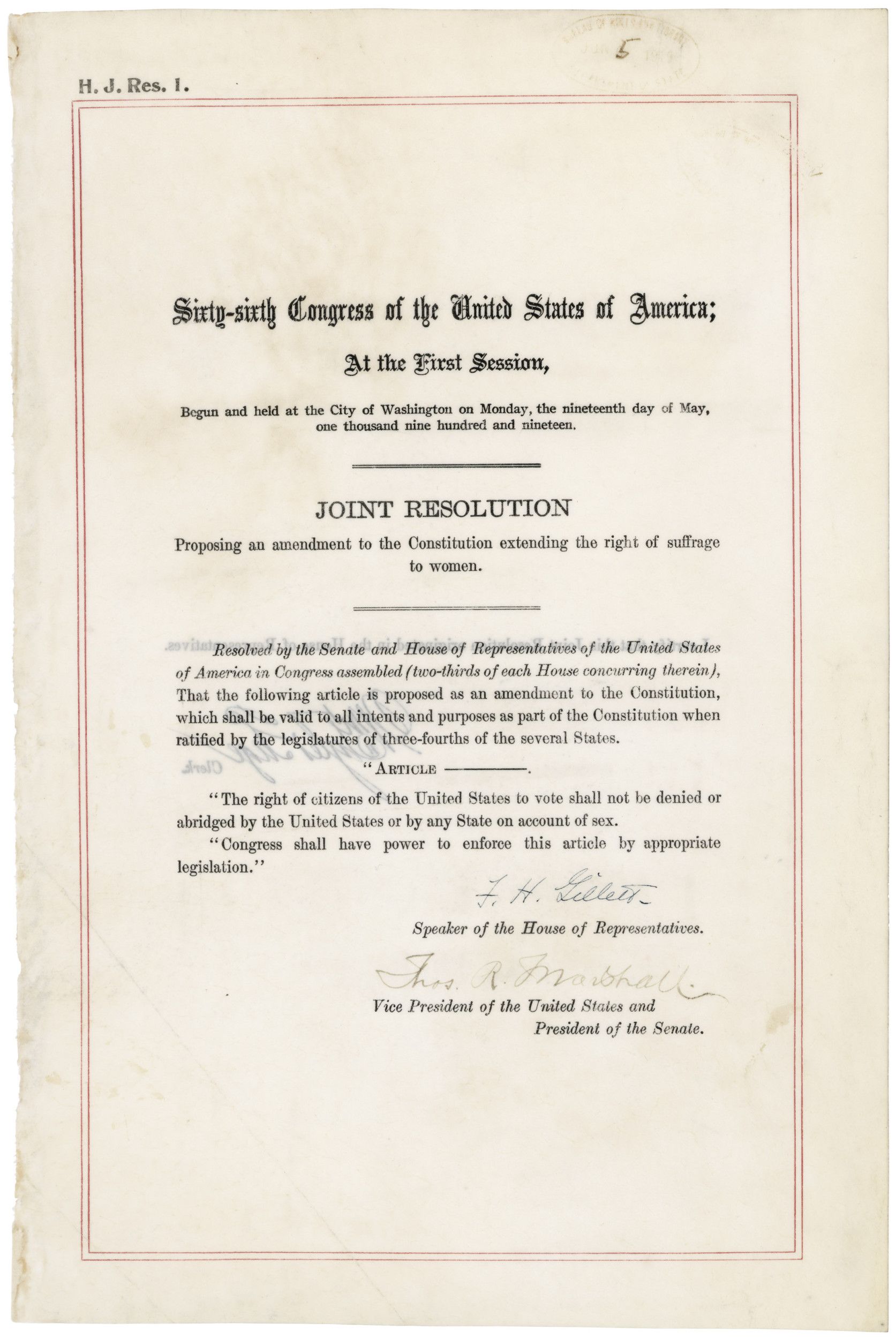19th Amendment to the United States Constitution
6/4/1919
Add to Favorites:
Add all page(s) of this document to activity:

This document shows approval by both the House of Representatives and the Senate (by two-thirds vote in each house) of the proposed 19th amendment to the Constitution that "The right of citizens of the United States to vote shall not be denied or abridged by the United States or by any State on account of sex. Congress shall have power to enforce this article by appropriate legislation."
Despite opposition from southern states, both houses of Congress passed the 19th Amendment, proposing full voting rights for women, and sent it to the states for ratification. Three-fourths of the states, or 36 states at that time, had to ratify the amendment before it could be added to the Constitution. On August 18, 1920, after calling a special session of the state legislature, Tennessee became the 36th state to ratify the 19th Amendment, thereby legally enfranchising one-half of the people.
The campaign for woman suffrage was long, difficult, and sometimes dramatic, yet ratification did not ensure full enfranchisement. Many women remained unable to vote long into the 20th century because of discriminatory state voting laws.
The document shown here is the Congressional joint resolution proposing the 19th Amendment. A joint resolution is a formal opinion adopted by both houses of the legislative branch. A constitutional amendment must be passed as a joint resolution before it is sent to the states for ratification.
Despite opposition from southern states, both houses of Congress passed the 19th Amendment, proposing full voting rights for women, and sent it to the states for ratification. Three-fourths of the states, or 36 states at that time, had to ratify the amendment before it could be added to the Constitution. On August 18, 1920, after calling a special session of the state legislature, Tennessee became the 36th state to ratify the 19th Amendment, thereby legally enfranchising one-half of the people.
The campaign for woman suffrage was long, difficult, and sometimes dramatic, yet ratification did not ensure full enfranchisement. Many women remained unable to vote long into the 20th century because of discriminatory state voting laws.
The document shown here is the Congressional joint resolution proposing the 19th Amendment. A joint resolution is a formal opinion adopted by both houses of the legislative branch. A constitutional amendment must be passed as a joint resolution before it is sent to the states for ratification.
Transcript
Sixty-sixth Congress of the United States of America; At the First Session,Begun and held at the City of Washington on Monday, the nineteenth day of May, one thousand nine hundred and nineteen.
JOINT RESOLUTION
Proposing an amendment to the Constitution extending the right of suffrage to women.
Resolved by the Senate and House of Representatives of the United States of America in Congress assembled (two-thirds of each House concurring therein), That the following article is proposed as an amendment to the Constitution, which shall be valid to all intents and purposes as part of the Constitution when ratified by the legislature of three-fourths of the several States.
"ARTICLE ————.
"The right of citizens of the United States to vote shall not be denied or abridged by the United States or by any State on account of sex.
Congress shall have power to enforce this article by appropriate legislation."
[endorsements]
This primary source comes from the General Records of the United States Government.
National Archives Identifier: 596314
Full Citation: Nineteenth Amendment to the United States Constitution; 6/4/1919; Enrolled Acts and Resolutions of Congress, 1789 - 2011; General Records of the United States Government, Record Group 11; National Archives Building, Washington, DC. [Online Version, https://docsteach.org/documents/document/nineteenth-amendment, April 23, 2024]Activities that use this document
- Separation of Powers or Shared Powers
Created by the National Archives Education Team - The Amendment Process: Ratifying the 19th Amendment
Created by the National Archives Education Team
Rights: Public Domain, Free of Known Copyright Restrictions. Learn more on our privacy and legal page.



